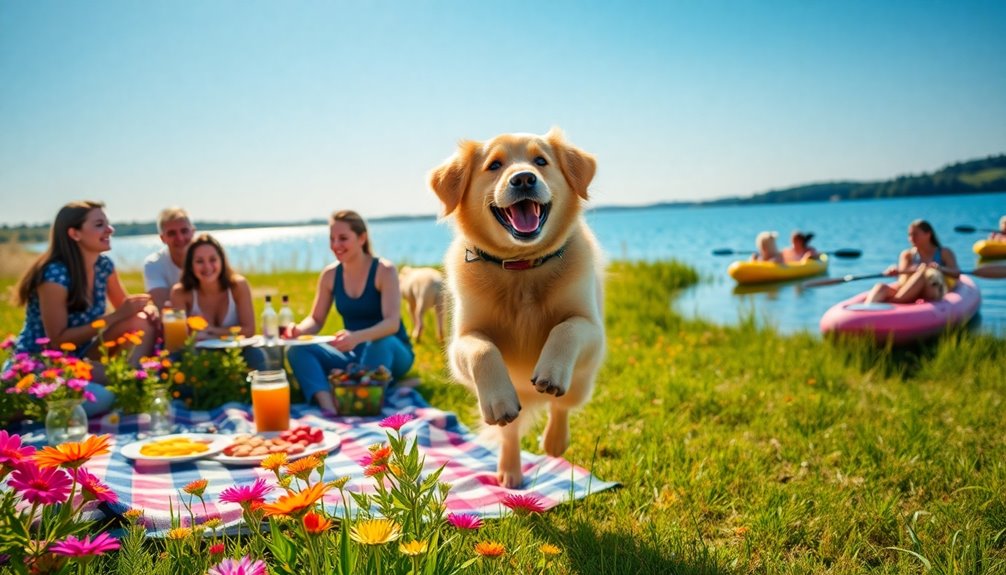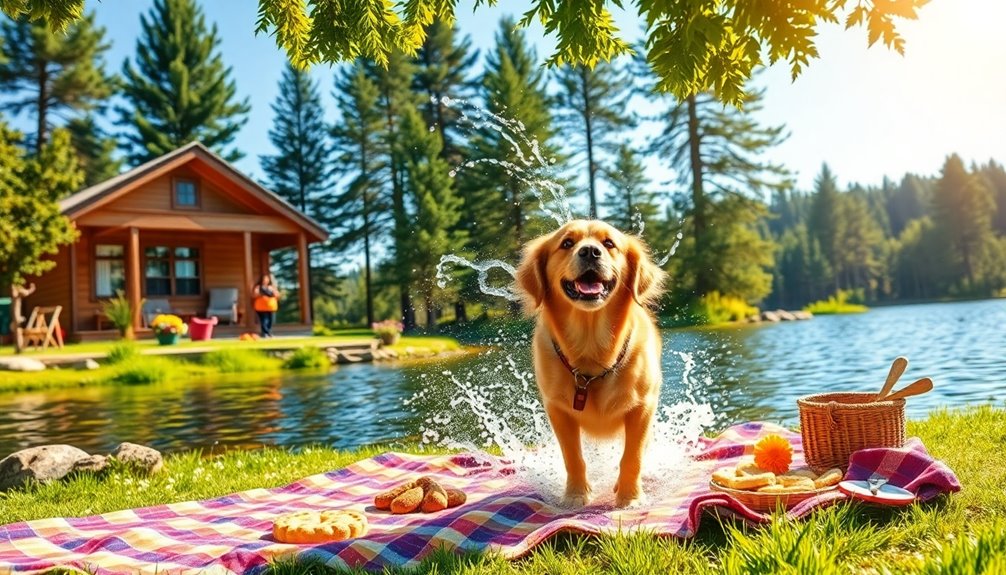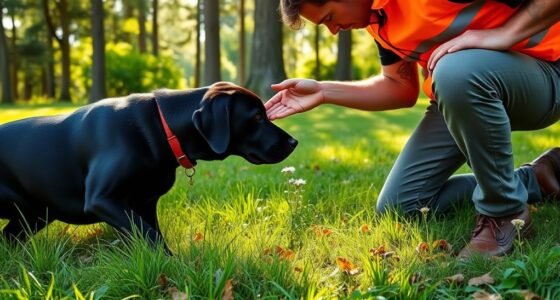To keep your dog mentally stimulated and prevent boredom, try introducing puzzle games that match their breed, age, and temperament. Use treats or favorite toys to motivate problem-solving and gradually increase difficulty as they improve. Tailoring puzzles to your dog’s natural instincts and providing positive reinforcement make playtime rewarding. Want to discover more ideas to boost your dog’s mental engagement? Keep exploring for tips that will enrich your pup’s daily routine.
Key Takeaways
- Match puzzle complexity to your dog’s breed, age, and temperament for optimal engagement.
- Use treats or toys as incentives to motivate problem-solving during puzzle play.
- Incorporate scent work or physical tasks to diversify mental stimulation and maintain interest.
- Gradually increase difficulty levels to challenge your dog and prevent boredom.
- Make puzzle activities a regular part of routines to promote consistent mental enrichment.

Mental puzzle games are an excellent way to keep your dog engaged and mentally stimulated, especially when physical exercise alone isn’t enough. These games challenge your dog’s problem-solving skills and help prevent boredom, which can lead to destructive behaviors. When introducing mental puzzles into your dog’s routine, it’s important to contemplate your dog’s breed, age, and individual temperament. Different breeds have varying levels of intelligence and problem-solving abilities, so selecting the right game can make all the difference in keeping your dog interested and motivated.
Mental puzzle games boost your dog’s brain and prevent boredom, tailored to breed, age, and temperament.
For example, highly intelligent breeds like Border Collies or Poodles thrive on complex puzzles that require critical thinking and quick decision-making. These breeds may grow bored with simple toys and need more challenging activities to stay engaged. Conversely, some breeds may prefer more straightforward puzzles or gentle, slower-paced games that don’t overwhelm them. Understanding your dog’s breed considerations helps you choose appropriate puzzle toys that match their natural instincts and abilities. This not only enhances their mental stimulation but also makes training sessions more effective, as it taps into their innate talents and curiosity.
When you start introducing puzzle games, keep in mind that patience is key. Your dog might initially struggle to solve the puzzle, but with gentle encouragement and positive reinforcement, they’ll learn to approach the challenge with enthusiasm. Use treats or favorite toys as incentives to motivate your dog and reinforce successful problem-solving. As your dog becomes more adept, you can gradually increase the difficulty level or switch to more complex puzzles to keep their mind sharp and curiosity piqued.
It’s also helpful to incorporate elements of dog training into puzzle play. For instance, you can teach your dog to open compartments or move pieces in a certain way, reinforcing commands and obedience skills while engaging their mind. This makes the activity more than just play—it becomes a valuable training tool that stimulates their cognitive functions. Remember, each dog is unique, so observe how your dog responds to different puzzles and adjust accordingly. Some might enjoy puzzles that involve scent work, while others prefer puzzles that require physical manipulation.
Frequently Asked Questions
How Do I Choose the Right Puzzle Game for My Dog’s Size?
To choose the right puzzle game for your dog’s size, consider dog size considerations and puzzle difficulty levels. Small dogs need compact, gentle puzzles, while larger dogs can handle bigger, more challenging ones. Match the difficulty level to your dog’s problem-solving skills, starting simple and increasing complexity gradually. Always supervise playtime, and pick puzzles that are safe, durable, and appropriate for your dog’s age and strength.
Are Mental Puzzles Suitable for Puppies or Senior Dogs?
Think of mental puzzles as a gentle breeze, soothing puppies’ developing minds and sharpening senior dogs’ fading cognition. They’re suitable for both, nurturing puppy development with age-appropriate challenges and keeping senior cognition lively. Choose puzzles that match your dog’s age and ability, ensuring they’re safe and engaging. With patience, you’ll see your furry friend blossom, their minds blossoming like spring flowers, full of curiosity and joy.
How Often Should I Introduce New Puzzle Games?
You should introduce new puzzle games every few days to keep your dog engaged and prevent boredom. Maintain a consistent training frequency, gradually increasing complexity as your dog masters each game. Changing puzzles regularly challenges your dog’s mind and encourages problem-solving skills, making playtime more stimulating. Remember, mixing things up prevents your dog from losing interest and ensures they stay mentally sharp and happy.
Can Mental Games Replace Physical Exercise for My Dog?
You can’t rely solely on mental games, as they won’t replace the physical rush of running through a park or chasing a ball. While mental exercises stimulate your dog’s mind, overdoing them can cause cognitive overload or behavioral burnout. Imagine a dog exhausted from both mental and physical stress—your goal is balance. Combine puzzle games with active play to keep your dog happy, healthy, and mentally engaged without risking burnout.
What Are Signs My Dog Is Struggling With a Puzzle?
If your dog is struggling with a puzzle, look for behavior cues like pawing, barking, or sniffing excessively, which signal frustration. They might also chew or try to escape the puzzle, showing they’re overwhelmed. Watch for signs of stress, such as yawning or lip licking. These frustration signals indicate your dog needs a break or simpler activities, so adjust the puzzle difficulty to keep playtime positive and engaging.
Conclusion
Now that you have some engaging mental puzzle games for your dog, you’ll notice their playtime becomes more stimulating and rewarding. These activities not only challenge their minds but also strengthen your bond. Are you ready to turn everyday moments into enriching adventures? With a little creativity, you can keep your furry friend mentally sharp and happy, making every day a new opportunity for fun and learning. So, why not start today and see the positive difference it makes?










